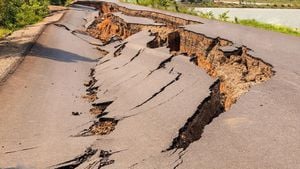The Pacific Northwest has been rocked by the effects of a bomb cyclone, dubbed by meteorologists as one of the most intense winter storms seen this decade. This powerful low-pressure system, which struck last week, has left destruction and chaos in its wake, particularly across the states of Washington and Oregon, as well as parts of British Columbia, Canada. Hurricane-force winds, torrential rains, and snow have caused significant disruptions, resulting in widespread power outages, structural damage, and unfortunately, fatalities.
Footage captured from satellites illustrated the storm’s enormity, showcasing the cyclone swirling ominously off the coast of Washington, about 300 miles away. According to reports, this bomb cyclone was rapidly intensifying, which contributed to its destructive potential, wreaking havoc across the Pacific Northwest.
Local authorities reported at least two deaths due to the storm, with the most recent being attributed to falling trees. Emergency services were stretched thin as they attempted to clear debris and restore power to more than 600,000 residents who found themselves without electricity during the week of devastation. Streets were littered with toppled trees and downed power lines, complicacing the response efforts.
T-Mobile was one of the companies stepping up to assist the community amid these challenges. On November 22, the company announced extensive restoration efforts, deploying over 180 generators to affected areas including Issaquah, Sammamish, and Bellevue. Their emergency teams worked diligently to restore wireless service to the vast majority of impacted areas, utilizing heavy-duty equipment like Satellite Cell on Light Trucks (SatCOLTs) and Satellite Cells on Wheels (SatCOWs) to provide connectivity where commercial power was unavailable.
Businesses like Verizon also joined the recovery initiatives, announcing a $25,000 donation to Hopelink, which focuses on providing food assistance to the hardest-hit areas. Steven Keller, Verizon's Pacific Market President noted, "Our hearts go out to those impacted by the storm...this donation is a testimony to our commitment to supporting communities during challenging times." This aid is particularly important as many families faced food insecurity due to the storm's impact on supply chains and local businesses.
But restoring power and connectivity is just one piece of the puzzle. Local officials emphasized the need for preparation. With winter storms expected to continue, residents were advised to create emergency kits filled with essentials like food, water, flashlights, and first aid supplies. They were encouraged to store extra food and supplies to sustain themselves during prolonged outages. "It pays to be prepared for emergencies," said Susanna Trimarco, public outreach coordinator for King County's Office of Emergency Management.
Preparations can include stocking up on items typically used during winter storms. Experts recommend having readily accessible supplies for use if the power goes out, such as batteries, charged power banks for devices, and, of course, keeping at least half a tank of gas, especially during potential evacuations.
Weather specialists attribute the bomb cyclone phenomenon to climate change as well, noting alarming trends of more frequent and intense storms. The increasing average temperatures of the oceans have been linked to the rapid intensification of such weather systems, raising concerns among climate scientists about what can be expected moving forward.
The technical term “bomb cyclone” describes these storms based on their explosive intensity; they occur when the central atmospheric pressure drops significantly within 24 hours. Brian McNoldy, Senior Research Associate at the University of Miami, explained, "It develops with ferocity we rarely, if ever, see over land." This alarming trend does not just threaten coastal states but entire regions as storm systems become increasingly erratic and unpredictable.
Multiple attempts to measure the storm's impact resulted in staggering numbers. According to Aon, the insurance firm, insured losses from the bomb cyclone are expected to reach tens of millions of dollars, and this number may rise as assessments are conducted. It fears the repercussions of such storms could continue to escalate, impacting both individual homeowners as well as local businesses.
The urgency to adapt to such changing climate conditions extends beyond emergency response; it also calls for technology infrastructure improvements, including restoring and maintaining communication lines during times of disaster. Local phone carriers and businesses alike are urged to implement plans to assist local emergency agencies, creating networks capable of supporting response efforts.
With the weather steadily growing less predictable, residents cannot afford to lower their guard. Cold fronts and even more storm systems are likely to follow, mixing with the atmospheric rivers expected over the coming months. This means continued vigilance and adaptation may be necessary for those living and working within the Pacific Northwest.
Cleanup continues across the Pacific Northwest as recovery efforts ramp up. Local officials recognized the challenges residents will face as they navigate the aftermath of such destructive storms. Over the coming weeks, the focus will be on restoring normalcy, with utility crews working around the clock to reconnect power and provide safety inspections on compromised structures.
Individuals and households struggling during this difficult time are encouraged to reach out to local assistance programs for support. The severity of this bomb cyclone serves as both a wake-up call and reminder as residents move forward, facing not just the remnants of this storm but what may be yet to come. Solid preparation strategies, community cooperation, and the seamless collaboration of emergency services may determine how well they weather future storms.
While this event may have left its mark, the Pacific Northwest historically has shown resilience and adaptability. A spirit of cooperation is being reignited within affected communities, reminding everyone of the importance of being prepared and united during tough times. If there's anything we can take away from this storm, it’s the importance of awareness, preparedness, and the willingness to come together.



